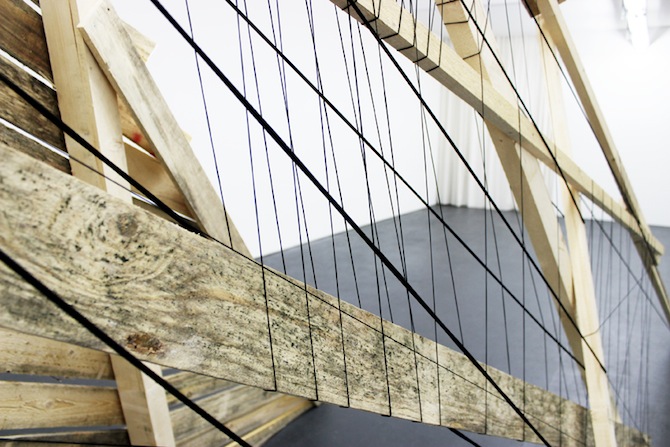
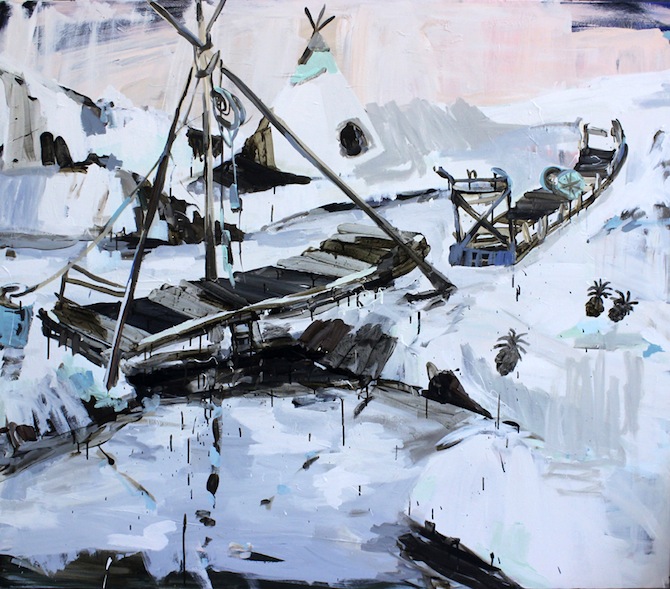
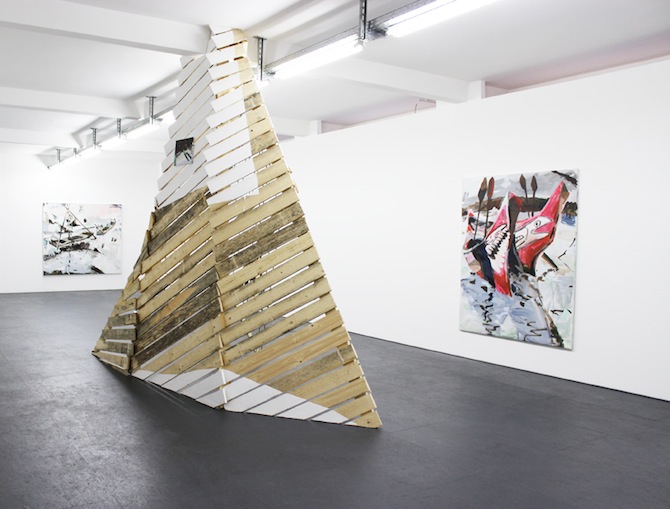
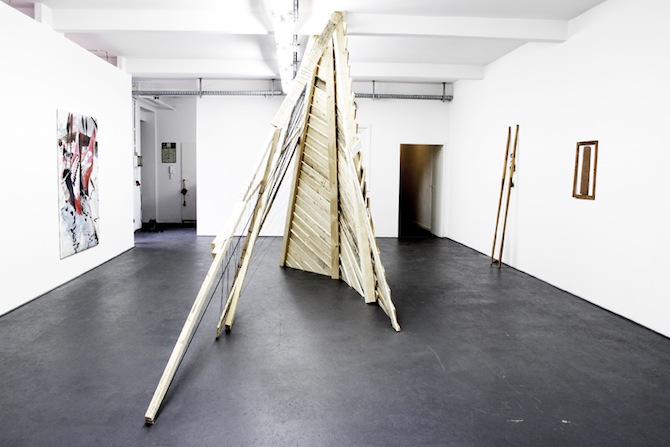
All images: Mie Olise, "Between the Stratum and the Unstable" at DUVE Berlin, March 7 – April 17, 2014, Courtesy Mie Olise and DUVE Berlin
Massive roller coasters, dramatic vessels and houses lifted by scaffolds – Mie Olise, a 1974-born artist from Denmark – strategically dissembles the constructions of large architectural objects, in order to use their most basic composition as motifs for her art. Each project, often including paintings and wooden installations, is carefully researched and accompanied by a profound background story – whether it is real or fictional. Having studied both, architecture and art, Mie still intertwines the aesthetics of both disciplines with each other. In her current show *Between the Stratum and the Unstable* at DUVE Berlin, she investigates the visual and architectural language of the native Indians and experiments with other media, such as yarn and fabrics. In an interview, she answered us questions about her practice, her inspiration and her daily working routine.
Anna-Lena Werner: Mie, a consistent topic within your work – your paintings and sculptures –is that of constructions. How is this interest related to your first university degree, which you did in architecture?
Mie Olise: I navigated my way through architecture school, experimenting with space, construction and hybrids on the edge of architecture, and I never saw myself in an architectural office afterwards. I was just hooked on studying the subject, and kind of just continued that in my artwork. Right after school I started a small exhibition space in Copenhagen, a lab for art and architecture where we experimented with the body in the city. And all along, since the age of 15, I have been painting. So it all relates I guess. Even though my paintings in the early years felt to have little to do with the other experiments. It was around the time when I did my MFA in London, that I became especially interested in bringing the paintings and the constructions together. Both as concepts and structures.
Anna-Lena: Architecturally, the constructions have often been massive: Container ships, train stations and fun parks belong to the motifs that you choose for your work. And each motif, it seems, brings a story that you research through various media. What makes a motif eligible for you to be an influence on your work?
Mie: In art school, because I had always been doing so many different things at once, I made a set of rules to work within (and clash against). One was that I would only work with these vessels and constructions, no human beings, no backgrounds. I like the scale to be 1:1, so the spectator or myself will be a part of the work. You – the viewer - would be the human figure. For many years I have been interested in how a construction or a place can inhabit stories and memories; and become the anchor for these things. There is always a specific reason why I am drawn to a place. Be it something real or a fiction. On some level, I believe my interest is rooted in a specific desire to grab hold of things as they slip away.
Anna-Lena: Your most recent project, which is currently exhibited at Galerie Duve Berlin, incorporates a folkloristic aesthetic that is inspired by objects of the native Indian. What is the story behind these images?
Mie: I have been in a process of wanting to lay down the barriers of my rules, to jump over the fence and taste what is over there. It has been a long process and I am in a place right now where it is sensational for me to discover these new ways of doing things. I have, almost in a new fractal layer, had the same argument that I used to have in architecture school on a more overall level – that of the painting and the construction and how they speak together.
So, by looking into the most basic elements of ships and houses, I have realised how we used to paint onto these constructions for different practical reasons. And I’ve been trying to dissect the same basic level of the painting. I am interested in the canvas that you paint on, how you make canvas, and how you can weave fabric or canvas into a construction, and paint on that. By borrowing into a native symbolic, I found a language that already used these expressions, and I have tried to speak; forming sentences that are building onto the things I am interested in, and have been investigating for the past years. This new language opened up to doing some new things in the paintings too. For example the whiteness and the colour red, that I have previously never really liked. Putting the canvas horizontal and working with some kind of background.
Anna-Lena: One of your former series includes a number of paintings, showing houses, which are lifted by a scaffold or which seem to be stretched from the ground. Is there a sense of dreaminess involved in these works?
Mie: Being interested in constructions, it is always interesting to know the ground. And by lifting the ships and houses up I have aimed at not showing the final answer – where and how the construction was situated. To not be situated or connected, I guess, could be said to be dreamy.
Anna-Lena: Your palette is extremely colourful, while the motifs often appear dramatic, even daunting. I wonder, do you consider your work as cheerful?
Mie: No. I actually feel like my use of colour is the least daring in my practice. For me, the colours acts as dots and I have a very strict idea of what I can do – and maybe especially what I cannot do. Like bright green, yellow and red together. My favourite colour is definitely brown. I am trying to push my colour scheme at the moment and that might be a new rule-set for me at one point.
Anna-Lena: In your current show in Berlin, you introduce several materials that are relatively new to your work, such as fabrics and yarn. Why did you decide to include these materials?
Mie: I have been working with these materials a lot earlier in my practice. About ten years ago, I was building quite a lot of weaves and looms. At ABC last year, I hung the painting onto the construction for the first time, which was a new attempt at speaking that language I am referring to above. The materials became part of the dissection of the painting; the canvas as a woven piece of fabric, the loom as a construction. The aim was to walk on a path between painting and construction.
Anna-Lena: These constructions that you mentioned, which you mostly create from wood, usually complemented your paintings in the past years. Suddenly they served as walls for your paintings. How did that change your perception of the wooden sculptures or constructions?
Mie: I was really surprised by how that worked. I had always refused the idea. But now I realised that it did something new and constructive to both formats; mediums that I know very well on their own. Together, they created a kind of a new space for me.
Anna-Lena: How does a typical working day of yours look like?
Mie: I am an artist who is really depended on studio-time and making. I build, make frames, weave and paint. For me, the studio is a workshop.
I usually go into the studio early and make a coffee, then I do some officing on the computer. I prefer to work in the studio by myself and I like to walk around the work in silence. In my painting, the energy of the brushstroke is important – if it does not sit there the first time, it is all over again. I try to get to the making part early, so I have time in-between decisions during the day. Time to look. And often I leave the last decision of the day to the next morning, then there is a welcome for you - something to do, and you are already inside again.
Anna-Lena: After 8 years of living in London and New York, you returned to Copenhagen in Denmark. How does it feel to be back?
Mie: It feels good. I have much more time to work and focus in Copenhagen, using less time on transport and so on. I can go everywhere on my bike. I have also realised that I do not know Copenhagen that well anymore and it is nice to walk over your paths again. I have lived in Copenhagen three times, every time with eight years in-between. And now I remember how I biked around the first time, very close to where my studio is now. Looking for the old train tracks and looking at the ruins. The ruins are all gone now – but the abandoned train tracks are still there. In Copenhagen you have to look closer to find what is obvious in London or New York. And there are many things that are just not there. But that is OK for a while. Missing things can be good for an artist - longing for that which is no longer there.
Anna-Lena: What is next on your exhibition agenda?
Mie: I am currently working on my contribution for a group show at UMOCA (Museum of Contemporary Art in Utah, USA), together with a bunch of great Danish artists like Olafur Eliasson, Elmgren/Dragset and Superflex. Here I will be building the shipsearching construction that I first presented at Honor Fraser gallery in 2011. Meanwhile, I’m also co-curating a group show of painting for a Lower East Side gallery in New York, as well as working towards my first solo with Samuel Freeman in LA this fall. Another thing that I’m quite excited about is my first bridge! It is a public commission, a large wooden bridge for walking and bicycling that is crossing 16 m of water.
Anna-Lena: Where is this bridge going to be?
Mie: It is going to be at the harbour in the city of Holbaek, Denmark. Where I also did a commission last year - a huge wall painting on the city council, as a part of the project "How far is the Horizon", curated by Solvej Helveg Ovesen.
MIE OLISE
*Between the Stratum and the Unstable*
March 7 – April 17, 2014
DUVE BERLIN
Gitschiner Strasse 94/94a
(Entrance D, Floor 2)
10969 Berlin
Opening Hours: Tue - Fri 11 - 18h, Sat 12-16h
www.mieolise.com
Anna-Lena: Where is this bridge going to be?
Mie: It is going to be at the harbour in the city of Holbaek, Denmark. Where I also did a commission last year - a huge wall painting on the city council, as a part of the project "How far is the Horizon", curated by Solvej Helveg Ovesen.
MIE OLISE
*Between the Stratum and the Unstable*
March 7 – April 17, 2014
DUVE BERLIN
Gitschiner Strasse 94/94a
(Entrance D, Floor 2)
10969 Berlin
Opening Hours: Tue - Fri 11 - 18h, Sat 12-16h
www.mieolise.com
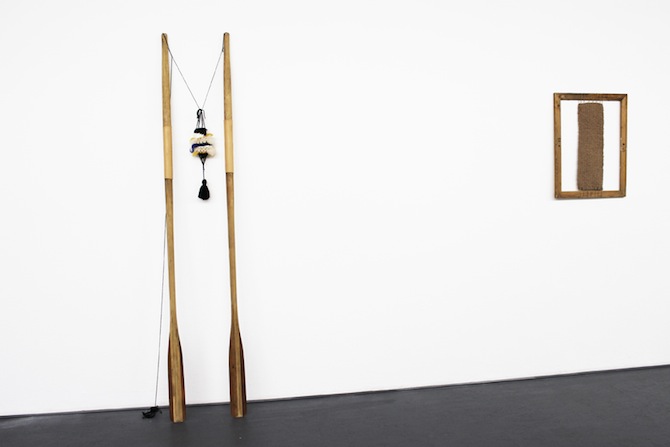
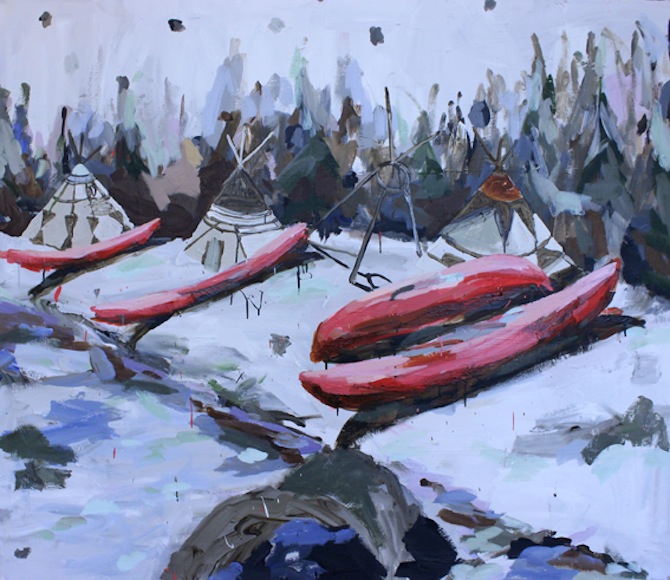
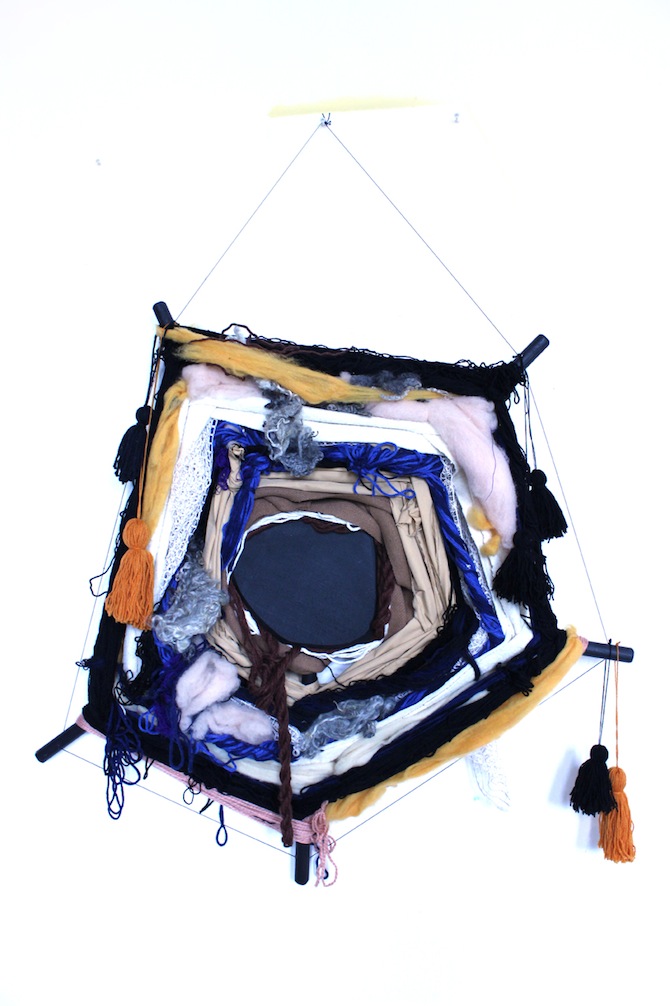
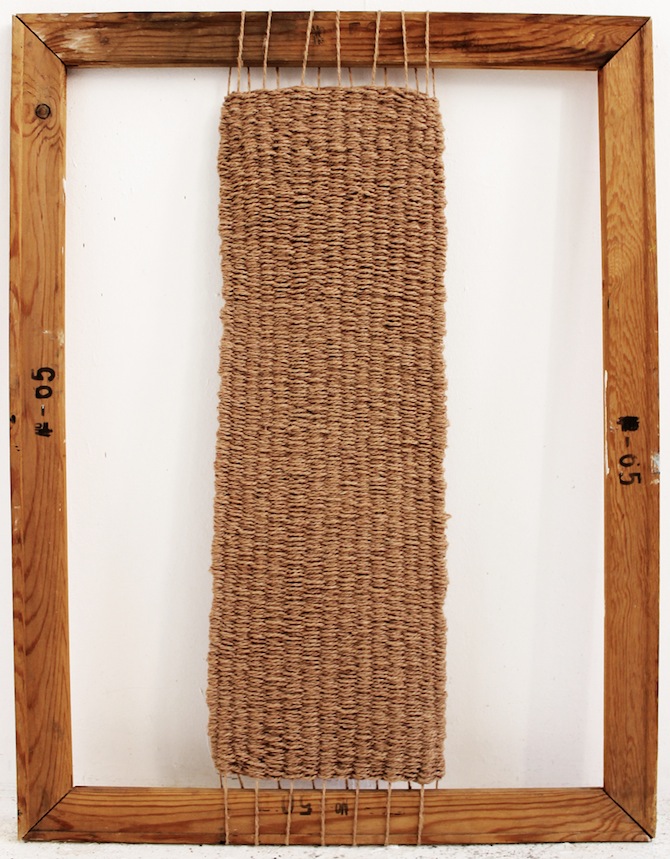
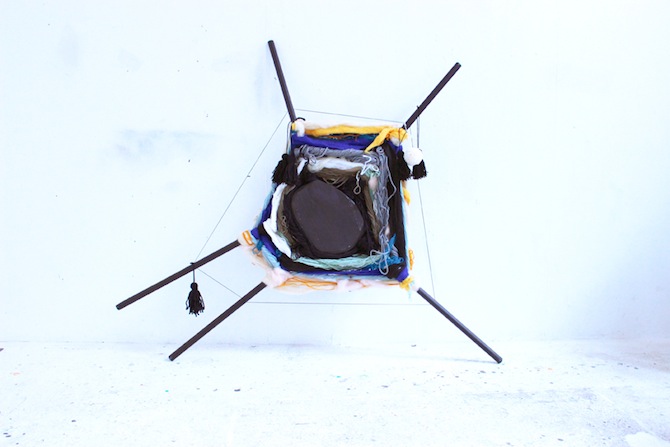
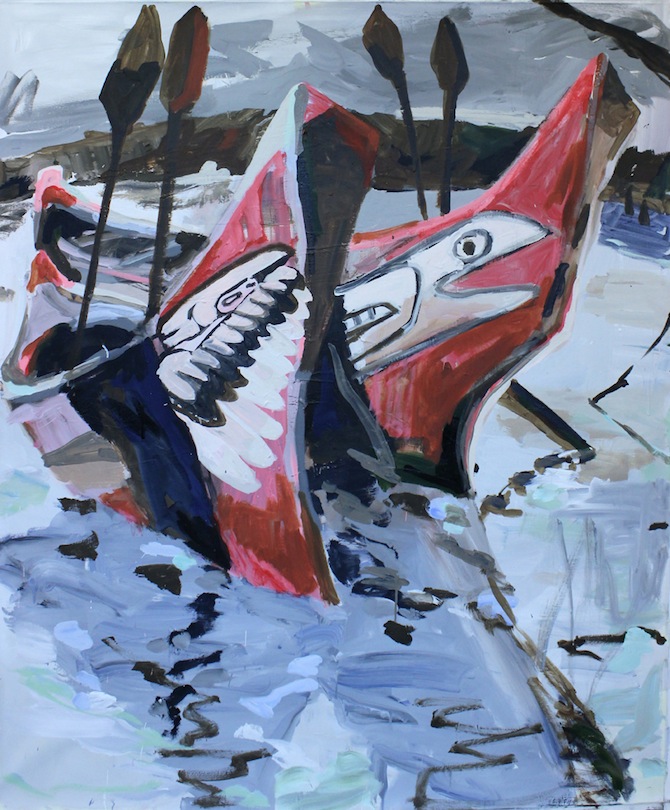
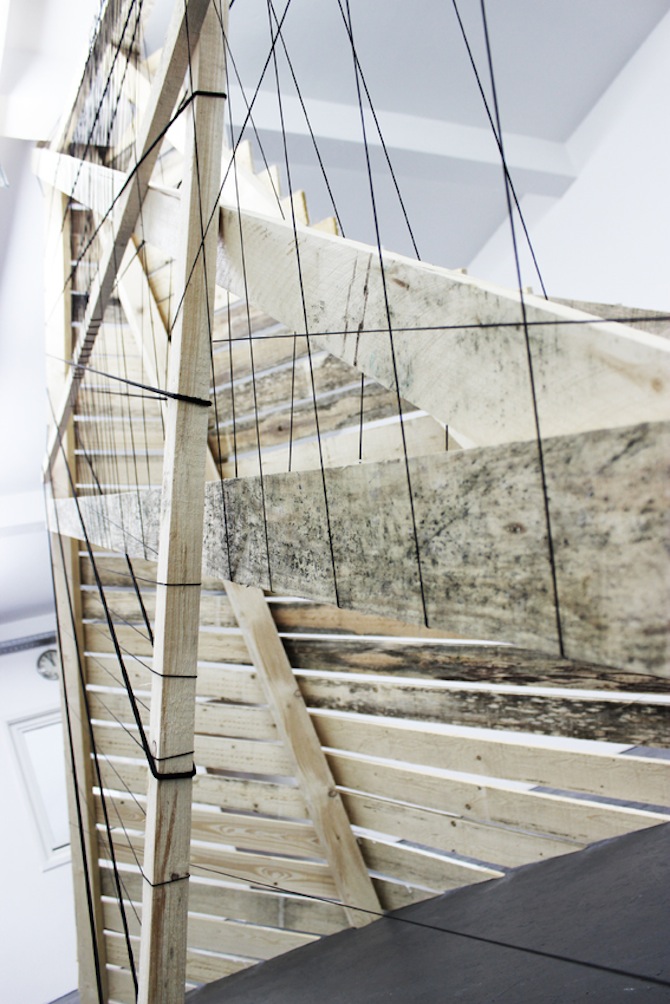
All images: Mie Olise, "Between the Stratum and the Unstable" at DUVE Berlin, March 7 – April 17, 2014, Courtesy Mie Olise and DUVE Berlin
